Canes Venatici: The celestial hunting dogs and their stars
Are you curious about the stars and constellations that light up our night sky? Then look no further than Canes Venatici, a unique constellation that represents a pair of hunting dogs. With its fascinating mythological origins and a wealth of stars and deep-sky objects to explore, Canes Venatici offers a thrilling celestial adventure. In this article, we will take a close look at the stars that make up this constellation, uncover its mythological roots, delve into its notable features, and provide insights into exploring the wonders of Canes Venatici. So, grab your telescope and get ready to embark on a journey through the cosmos with the celestial hunting dogs and their stars.
Contents
- Overview of Canes Venatici
- Stars in Canes Venatici
- Mythological Origins
- Features of Canes Venatici
- Exploring Canes Venatici
- Conclusion
-
Frequently Asked Questions
- 1. What does “Canes Venatici” mean?
- 2. How can I locate Canes Venatici in the night sky?
- 3. What are some notable deep-sky objects in Canes Venatici?
- 4. Is Canes Venatici visible from both hemispheres?
- 5. How far away are the stars in Canes Venatici?
- 6. Are there any mythology or stories associated with Canes Venatici?
- 7. Can I see Canes Venatici with the naked eye?
- 8. What is the Whirlpool Galaxy in Canes Venatici?
- 9. Can I capture images of Canes Venatici with a camera?
- 10. Are there any constellations that are closely associated with Canes Venatici?
- References
-
Frequently Asked Questions
- 1. What are the main constellations in Canes Venatici?
- 2. How did the constellation Canes Venatici get its name?
- 3. What are some notable stars in Canes Venatici?
- 4. What is the significance of Alpha Canum Venaticorum?
- 5. What makes Beta Canum Venaticorum unique?
- 6. What is the story behind the star La Superba?
- 7. What are the Whirlpool Galaxy and the Sunflower Galaxy?
- 8. Are there any other notable deep-sky objects in Canes Venatici?
- 9. Can Canes Venatici be seen from both hemispheres?
- 10. How can I explore Canes Venatici?
- References
- Read More
Overview of Canes Venatici
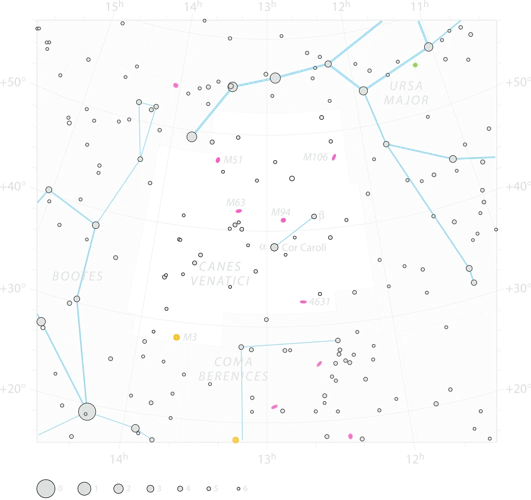
Canes Venatici, also known as the Hunting Dogs, is a small constellation located in the northern sky. It is situated between the constellations Ursa Major and Boötes. In terms of size, it ranks 38th out of the 88 officially recognized constellations. Canes Venatici is notable for its two bright stars, which form the “dogs” in its name. These stars are known as Alpha Canum Venaticorum (also called Cor Caroli) and Beta Canum Venaticorum. Cor Caroli, the brighter of the two, is a binary star system approximately 115 light-years away from Earth. It is classified as an A-type main-sequence star and is known for its bluish-white color and its role as a guidepost for navigating the night sky. Beta Canum Venaticorum, on the other hand, is a yellow-white main-sequence star located around 27 light-years away. It is relatively faint compared to Cor Caroli but still contributes to the overall beauty and charm of the constellation. In addition to its prominent stars, Canes Venatici is also home to galaxies and other deep-sky objects, making it an exciting destination for astronomers and stargazers alike.
Stars in Canes Venatici
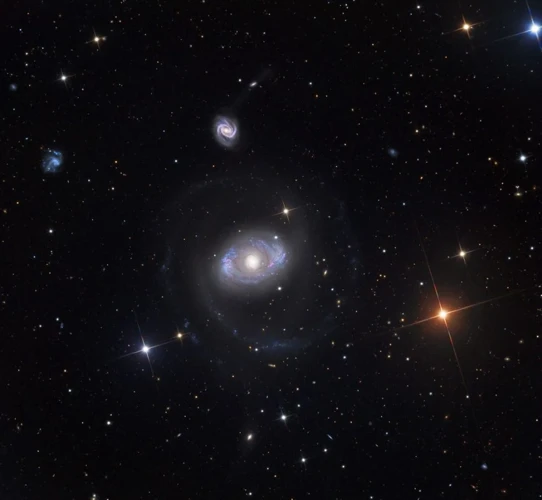
In the constellation of Canes Venatici, there are several notable stars that captivate astronomers and stargazers. One such star is Alpha Canum Venaticorum, also known as Cor Caroli, which serves as a guidepost in the night sky. This binary star system consists of a primary star and a smaller companion. Cor Caroli shines with a bluish-white brilliance and is located approximately 115 light-years away from Earth. Another star of significance in Canes Venatici is Beta Canum Venaticorum, which is a yellow-white main-sequence star situated about 27 light-years away. While less luminous than Cor Caroli, Beta Canum Venaticorum still adds to the constellation’s allure. These stars, along with others in Canes Venatici, contribute to the celestial beauty and intrigue of this constellation, making it a fascinating area of study for astronomers and all those interested in the wonders of the night sky.
1. Alpha Canum Venaticorum
Alpha Canum Venaticorum, also known as Cor Caroli, is one of the brightest stars in the constellation Canes Venatici. It holds a special place in both mythology and astronomy. The name Cor Caroli translates to “Charles’ Heart,” which is in honor of King Charles I of England, as it was named by the astronomer Sir Charles Scarborough in the 17th century. This binary star system consists of two stars, with the primary star being a white main-sequence star and the secondary star being a fainter companion. Cor Caroli is located around 115 light-years away from our solar system. It has a luminosity approximately six times that of our Sun and a surface temperature of around 8,500 Kelvin. In terms of its appearance, the primary star of Cor Caroli appears blue-white, adding to the beauty of the constellation. Its brightness makes it easily visible to the naked eye, and it serves as a useful guide for amateur astronomers in locating other celestial objects. Cor Caroli is also associated with the zodiac sign Gemini, which has its own intriguing personality traits and characteristics – find out more! Alpha Canum Venaticorum (Cor Caroli) is a fascinating star that has captured the attention of stargazers throughout history with its beauty and significance.
2. Beta Canum Venaticorum
Beta Canum Venaticorum is a yellow-white main-sequence star located in the constellation Canes Venatici. It is the second bright star that contributes to the overall beauty of the constellation. With a distance of approximately 27 light-years from Earth, Beta Canum Venaticorum is relatively close in cosmic terms. This star is classified as a G-type main-sequence star, similar to our Sun. Its spectral type is G0V, indicating that it is a relatively hot and luminous star.
Beta Canum Venaticorum is known for its stability and longevity, making it an interesting subject of study for astronomers. Its physical properties, such as mass, radius, and temperature, provide valuable insights into stellar evolution and the life cycle of stars like our Sun.
In addition to its scientific significance, Beta Canum Venaticorum also plays a symbolic role in astrology. Astrologers associate the star with personal growth and the exploration of one’s potential. Its position in Canes Venatici adds to the mystique and influence that enthusiasts believe it holds over personality traits and individual destiny. So, whether you’re an enthusiast of astronomy or astrology, Beta Canum Venaticorum is a star worth observing and contemplating.
3. La Superba (Y Canum Venaticorum)
La Superba, also known as Y Canum Venaticorum, is a fascinating star located within the constellation Canes Venatici. It is a red giant star that stands out due to its vibrant and intense red color, hence the name “La Superba,” which means “the superb” in Italian. La Superba is approximately 710 light-years away from Earth and has a diameter over 350 times that of our Sun. It is classified as a M-type giant star and is known for its irregular variability, meaning that its brightness fluctuates irregularly over time. The cause of this variability is still not completely understood by astronomers, adding to the intrigue of this exceptional celestial object. In addition to its unique color and variability, La Superba also emits a strong infrared glow, making it an interesting target for scientific observations. Its characteristics have been studied in relation to the study of cool, evolved stars and their atmospheres. La Superba serves as an example of the diverse and captivating stars that can be found within the constellation of Canes Venatici, making it a delight for astronomers and enthusiasts to explore.
Mythological Origins
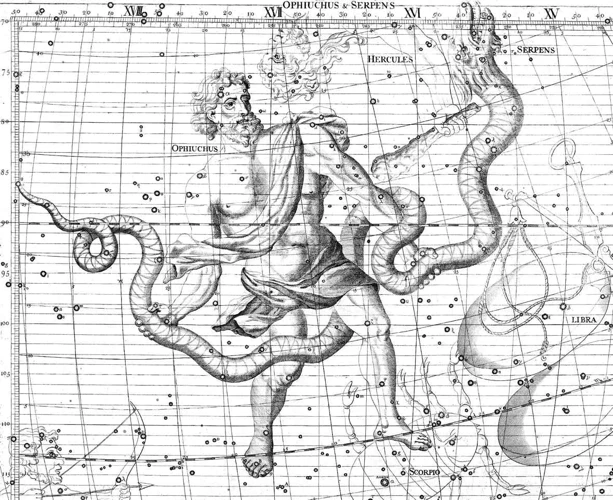
The mythological origins of Canes Venatici are closely tied to the legend of Boötes, the Herdsman. In Greek mythology, Boötes was said to be a skilled hunter and caretaker of the celestial animals. According to one version of the story, Boötes had two loyal hunting dogs, Asterion and Chara, who aided him in his pursuit of prey. These faithful dogs were immortalized in the stars as the constellation Canes Venatici. In another interpretation, Canes Venatici represents the hunting dogs of the goddess Diana, who was known for her hunting prowess. Diana’s dogs were said to be swift and agile, always by her side during her hunts. This connection to hunting is reflected in the Latin name “Canes Venatici,” which directly translates to “hunting dogs.” The celestial presence of these loyal hunting companions serves as a reminder of the importance of loyalty and companionship in the pursuit of our own goals and aspirations.
Features of Canes Venatici
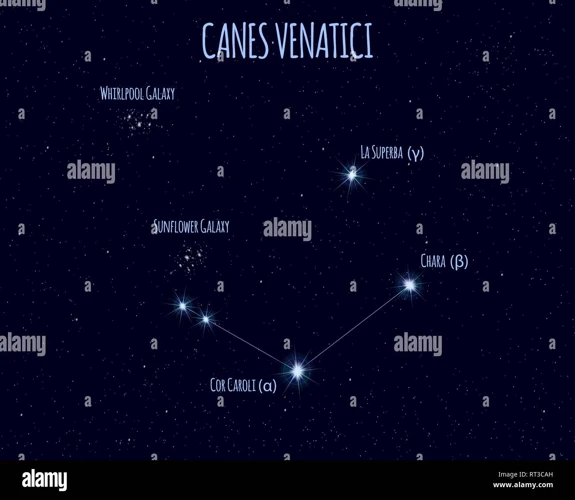
The constellation Canes Venatici offers a multitude of fascinating features for skywatchers to explore. One of its most notable features is the Whirlpool Galaxy, also known as M51. This stunning spiral galaxy, located approximately 23 million light-years away, gets its name from its distinct swirling appearance. With its intricate structure and bright star clusters, the Whirlpool Galaxy is a popular target for amateur astronomers. Another highlight within Canes Venatici is the Sunflower Galaxy, also called M63. This beautiful barred spiral galaxy is approximately 37 million light-years away from Earth and is known for its tightly wound spiral arms and vibrant star-forming regions. In addition to these prominent galaxies, Canes Venatici is home to other deep-sky objects, such as the breathtaking globular cluster Messier 3 and the stunning planetary nebula Messier 63. Exploring these celestial wonders in Canes Venatici is a captivating journey that unveils the immense beauty and grandeur of our universe.
1. The Whirlpool Galaxy
The Whirlpool Galaxy, also known as Messier 51a or NGC 5194, is one of the standout features in Canes Venatici. This stunning galaxy is a prime example of a grand design spiral galaxy, characterized by its distinct spiral arms and a bright central bulge. It earned its name due to its swirling appearance, resembling a cosmic whirlpool. The Whirlpool Galaxy is located approximately 23 million light-years away from Earth and spans across an impressive 60,000 light-years in diameter. Observing this galaxy, one can marvel at its intricate structure and the interplay of dust lanes and glowing star-forming regions within its arms. The Whirlpool Galaxy forms a captivating visual pair with its smaller companion galaxy, NGC 5195, which appears to be interacting with it. This interaction has sparked intense star formation and has resulted in a bridge of gas and dust connecting the two galaxies. The Whirlpool Galaxy serves as a perfect target for astrophotographers and amateur astronomers, showcasing the beauty and complexity of the universe we inhabit. Exploring the vastness of the cosmos, one cannot help but be in awe of the wonders that Canes Venatici has to offer.
2. The Sunflower Galaxy
The Sunflower Galaxy, also known as Messier 63 or M63, is one of the standout features of Canes Venatici. It is a stunning spiral galaxy located approximately 37 million light-years away from Earth. The galaxy gets its name from its distinctive appearance, as its spiral arms resemble the petals of a sunflower. M63 is classified as a flocculent spiral galaxy, which means its spiral arms are less defined compared to other spiral galaxies. It spans an impressive 100,000 light-years in diameter and contains billions of stars. The Sunflower Galaxy is a popular target for amateur astronomers due to its relatively bright magnitude and its contrasting spiral structure. Observation of M63 through a telescope reveals its intricate dust lanes, star-forming regions, and clusters of young stars. Its proximity to Earth provides astronomers with an opportunity to study the galaxy in detail and gain insights into the formation and evolution of spiral galaxies. Whether you’re a seasoned astronomer or a curious stargazer, the Sunflower Galaxy is sure to captivate your imagination and deepen your appreciation for the wonders of the cosmos.
3. Other Deep-Sky Objects
In addition to its notable stars, Canes Venatici is also home to various fascinating deep-sky objects that capture the attention of astronomers and astrophotographers. One of the most prominent objects in this constellation is the Whirlpool Galaxy, also known as M51 or NGC 5194. This stunning spiral galaxy is located approximately 23 million light-years away from Earth. It gets its name from its distinctive spiral structure, which resembles a swirling whirlpool. The Whirlpool Galaxy is interactively engaged with a smaller companion galaxy, known as NGC 5195. This interaction has caused intense star formation and the creation of beautiful celestial formations.
Next on the list is the Sunflower Galaxy, also referred to as Messier 63 or NGC 5055. Located approximately 37 million light-years away, this stunning galaxy derives its name from its bright, striking appearance. With its distinctive spiral arms stretching outwards, the Sunflower Galaxy showcases a plethora of young, hot stars that illuminate the intricate details of its structure.
Apart from these well-known deep-sky objects, Canes Venatici hosts a wide range of other galaxies, including the Black Eye Galaxy (M64 or NGC 4826) and the Needle Galaxy (NGC 4565). These galaxies provide a wealth of opportunities for stargazers to observe and explore the mysteries of our vast universe.
Whether you’re an amateur astronomer or simply intrigued by the wonders of the cosmos, Canes Venatici offers a captivating array of deep-sky objects that are waiting to be discovered and admired. So grab your telescope, head to a dark sky site, and be prepared to be mesmerized by the celestial treasures within this remarkable constellation.
Exploring Canes Venatici
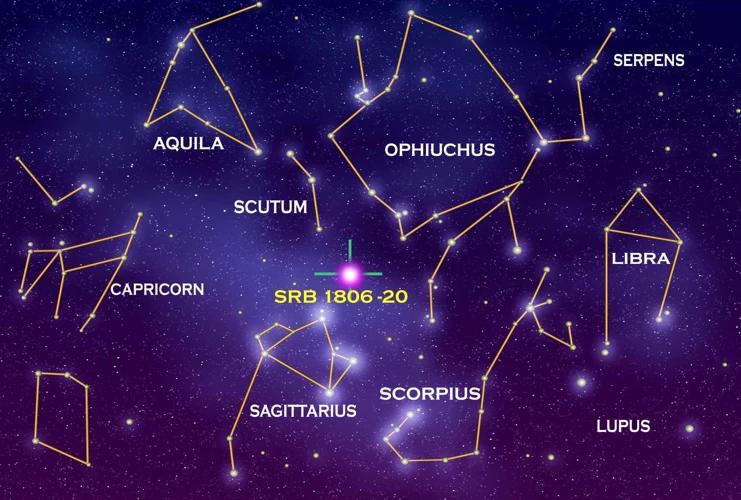
Exploring Canes Venatici opens up a world of celestial wonders. One of the standout features within this constellation is the Whirlpool Galaxy, also known as Messier 51a. This striking spiral galaxy is located about 23 million light-years away and is an ideal target for amateur astronomers. The Whirlpool Galaxy gets its name from its classic shape, with its spiral arms appearing as if they are swirling around a central core. It is actually interacting with a smaller companion galaxy, which adds to its unique appearance. Another notable deep-sky object in Canes Venatici is the Sunflower Galaxy, also known as Messier 63. This beautiful barred spiral galaxy is located approximately 37 million light-years away and showcases stunning spiral arms filled with young, hot stars. Its distinct yellowish color gives it the name of the Sunflower Galaxy, resembling the vibrant petals of the flower. Beyond these standout galaxies, Canes Venatici also hosts a variety of other deep-sky objects, including nebulae and star clusters, inviting astronomers to explore and unravel the mysteries of the universe. Whether you are a seasoned observer or just starting your astronomical journey, Canes Venatici offers a treasure trove of celestial delights to discover and appreciate. So grab your telescope and prepare to be mesmerized by the captivating wonders that await you in the hunting dogs’ domain.
Conclusion

In conclusion, Canes Venatici, the celestial hunting dogs, offers a fascinating journey through the night sky. From its two prominent stars, Alpha Canum Venaticorum and Beta Canum Venaticorum, to its captivating deep-sky objects like the Whirlpool Galaxy and the Sunflower Galaxy, this constellation provides a wealth of celestial wonders to explore. Whether you are an avid astronomer or simply an admirer of the night sky, Canes Venatici will not disappoint. So, grab your telescope and set out on a quest to unravel the mysteries of the universe. As you navigate the cosmos, let the hunting dogs guide you through the vastness of space, and who knows, you may uncover hidden prophecies like those of the Oracle of Delphi or even find personal growth and enlightenment in the astrological houses. The celestial wonders of Canes Venatici await, ready to inspire and captivate all who dare to look up and wonder.
Frequently Asked Questions

1. What does “Canes Venatici” mean?
The Latin term “Canes Venatici” translates to “hunting dogs.” The constellation represents two dogs from mythology, Asterion and Chara, who were known for their hunting prowess.
2. How can I locate Canes Venatici in the night sky?
Canes Venatici can be found between the constellations Ursa Major and Boötes. Look for the bright star Arcturus in Boötes, and you can trace a line from Arcturus to find Canes Venatici.
3. What are some notable deep-sky objects in Canes Venatici?
Canes Venatici is home to several fascinating deep-sky objects. Some of the most notable include the Whirlpool Galaxy (M51), the Sunflower Galaxy (M63), and the famous globular cluster M3.
4. Is Canes Venatici visible from both hemispheres?
Yes, Canes Venatici can be seen from both the Northern Hemisphere and the Southern Hemisphere. However, its visibility may vary depending on the season and the observer’s location.
5. How far away are the stars in Canes Venatici?
The distances to the stars in Canes Venatici vary. For example, Alpha Canum Venaticorum (Cor Caroli) is approximately 115 light-years away, while Beta Canum Venaticorum is around 27 light-years away from Earth.
6. Are there any mythology or stories associated with Canes Venatici?
Yes, Canes Venatici has mythological origins. It is believed to represent the hunting dogs that aided the hunter Boötes in his celestial hunts. The dogs were named Asterion and Chara in Greek mythology.
7. Can I see Canes Venatici with the naked eye?
Yes, some of the brighter stars in Canes Venatici, such as Cor Caroli, are visible to the naked eye. However, to fully appreciate the constellation and its deep-sky objects, a telescope or binoculars are recommended.
8. What is the Whirlpool Galaxy in Canes Venatici?
The Whirlpool Galaxy, also known as Messier 51 (M51), is a stunning spiral galaxy located in Canes Venatici. It is known for its spiral arms and a companion galaxy, which creates a mesmerizing visual appearance.
9. Can I capture images of Canes Venatici with a camera?
Yes, with the right equipment and techniques, it is possible to capture images of Canes Venatici. Astrophotographers often photograph the deep-sky objects within the constellation, showcasing their beauty for all to see.
10. Are there any constellations that are closely associated with Canes Venatici?
Canes Venatici is located near the constellations Ursa Major and Boötes. Ursa Major is known for its famous asterism, the Big Dipper, while Boötes represents a herdsman. These constellations are often seen together in the night sky.
References
Frequently Asked Questions

1. What are the main constellations in Canes Venatici?
The main constellations in Canes Venatici are Canes Venatici I and Canes Venatici II. Canes Venatici I is also known as the Greater Dog and Canes Venatici II is known as the Lesser Dog.
2. How did the constellation Canes Venatici get its name?
The name Canes Venatici is derived from Latin, meaning “hunting dogs.” The constellation represents the two hunting dogs of Boötes, the Herdsman.
3. What are some notable stars in Canes Venatici?
Some notable stars in Canes Venatici include Alpha Canum Venaticorum, Beta Canum Venaticorum, and La Superba (Y Canum Venaticorum).
4. What is the significance of Alpha Canum Venaticorum?
Alpha Canum Venaticorum, also known as Cor Caroli, is the brightest star in the constellation. It serves as a guidepost to locate other celestial objects in Canes Venatici.
5. What makes Beta Canum Venaticorum unique?
Beta Canum Venaticorum, also known as Chara, is an interesting star because it is a white main-sequence star that exhibits variable brightness. It can vary in magnitude and has a pulsating behavior.
6. What is the story behind the star La Superba?
La Superba, scientifically known as Y Canum Venaticorum, is a red carbon star. It derives its name from its incredibly deep red color and its extraordinary brightness. It is one of the most beautiful and striking stars in Canes Venatici.
7. What are the Whirlpool Galaxy and the Sunflower Galaxy?
The Whirlpool Galaxy, also known as Messier 51a, is a spiral galaxy located within Canes Venatici. The Sunflower Galaxy, also known as Messier 63, is another spiral galaxy situated in the constellation. Both are popular targets for astronomers and astrophotographers.
8. Are there any other notable deep-sky objects in Canes Venatici?
Yes, apart from the Whirlpool and Sunflower galaxies, Canes Venatici is home to various other deep-sky objects. These include the Black Eye Galaxy (Messier 64), the Needle Galaxy (NGC 4565), and the Cocoon Galaxy (NGC 4490).
9. Can Canes Venatici be seen from both hemispheres?
Yes, Canes Venatici can be seen from both the Northern and Southern Hemispheres. However, the constellation is more prominent and visible from the Northern Hemisphere.
10. How can I explore Canes Venatici?
You can explore Canes Venatici by using a telescope or binoculars. Look for the notable stars, galaxies, and deep-sky objects mentioned in this article. You can also join astronomy clubs or participate in stargazing events to learn more about this fascinating constellation.







